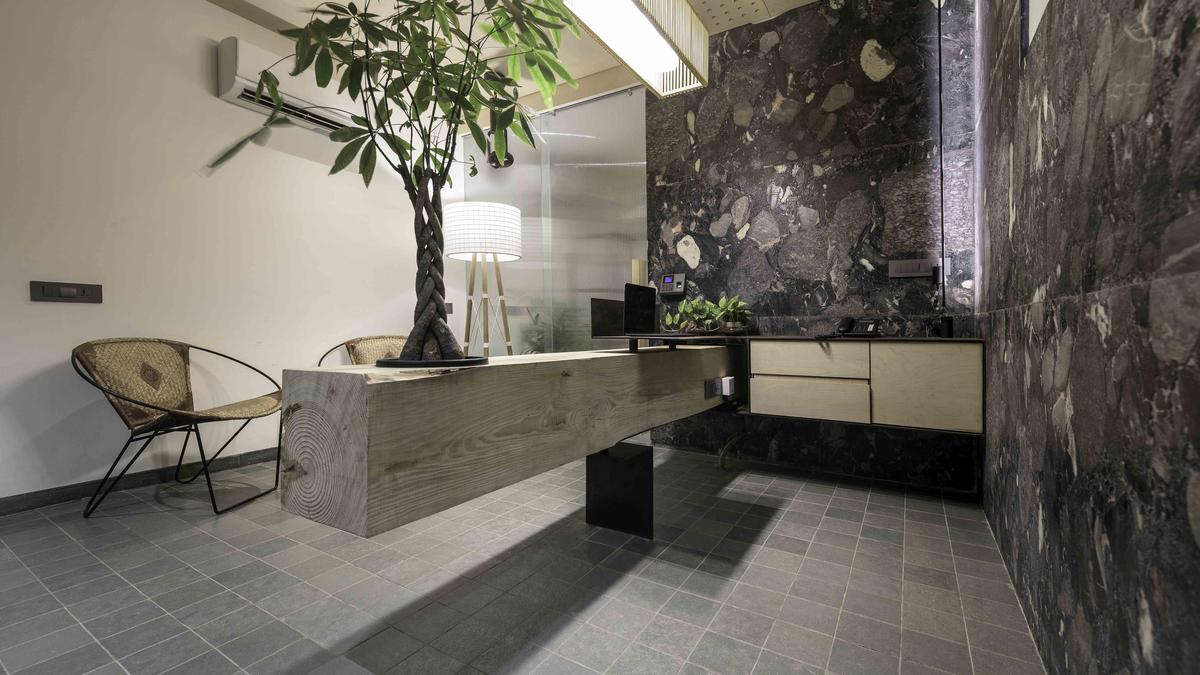Deadlines, budgets, client briefs, endless site visits — on most days, architects and designers are consumed by the needs of others. But ask them what they create when no one is watching, and the answers reveal something far more intimate. Designing for themselves becomes a rare pause, a chance to play, experiment, and express: a reminder of why they fell in love with design in the first place.
“Designing for ourselves is an adventure of creativity. I have a penchant for the fantastical, and I am drawn to all things brutalist. My partner, however, favours minimalistic aesthetics, deep, moody hues and has a keen focus on functionality and quality. Such projects reflect not just our tastes, but the rhythm of our lives together,” says Smita Thomas, founder, Multitude of Sins.
The Solo Waltz has been painted in a cherry red tone and blends seamlessly with the rest of the space by e & co.
| Photo Credit:
Ishita Sitwala
These projects are often an unfiltered expression of their unique design sensibilities and philosophy. “Without a client brief or external expectations, the only constraint is our own clarity of purpose. Such designs emerge from a space of freedom,” says Bhadri Suthar, co-Founder, tHE gRID Architects, Research & Design Studio.
Designing something for their own use always feels rewarding. “Unlike working on client projects where there are multiple perspectives and requirements to balance, creating for my own space gives me complete freedom to experiment, blend different influences, and push boundaries. It becomes an honest reflection of my own story, memories and aesthetic, almost like a diary entry captured in design,” says Nishtha Duggal, co-founder and principal, The Concreate Story. Further, designing for yourself often means designing from the depths of self and soul. “Designing for myself feels like a dialogue with my own instincts. Unlike commissioned work, where you respond to someone else’s story, here it becomes about looking within; what I need, what feels right, what makes me smile. They carry emotion as much as craft. There is a joy in creating without boundaries, where playfulness can meet function seamlessly. These moments of self-design are special because they are pure and they remind me why I fell in love with design in the first place,” says Eshita Marwah, founder, by e & co. Here is a look at some eclectic products designed by the architects for their own spaces.
Mind the chair | tHE gRID Architects, Research & Design Studio
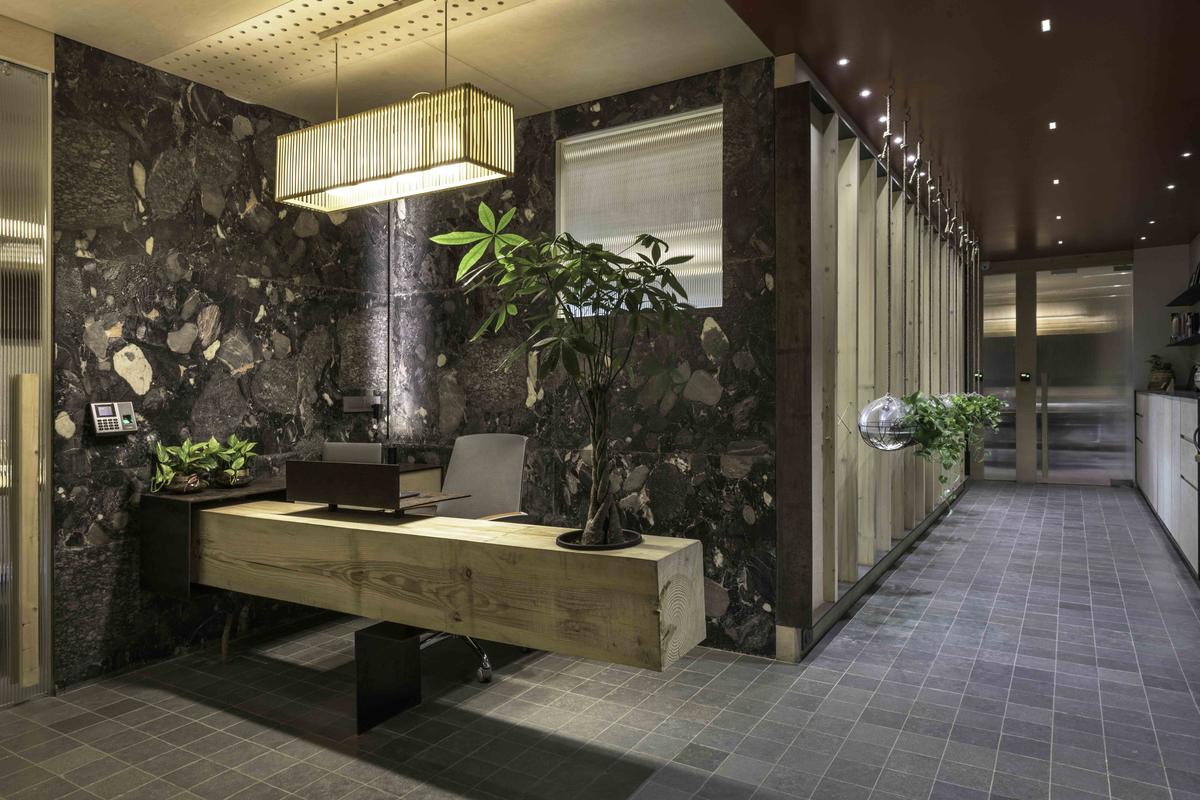
The raw log of wood symbolises nature and the live tree planted in the log stands for life on earth.
| Photo Credit:
PHX INDIA
Co-founders Bhadri and Snehal Suthar have designed an exclusive chair named ‘Inclinaire’ and a desk called ‘Eunoia’ for their office space. “They embody our core values of simplicity, honesty and love for nature. These pieces are not just objects — they are manifestations of our thinking, shaped by years of refining design to its essence and a constant urge to simplify,” says Snehal. Inclinaire, crafted from mild steel with hand-polished teak wood, draws inspiration from honesty of form, integrity of joinery and reverence for natural materials. The chair, which is ergonomically aligned with the body’s natural posture, is a lesson in restraint with the geometry balancing the lightness of form with structural solidity. There is minimal use of screws, and the perforated teak seat balances weight while enhancing comfort. “The idea was to distil a chair to its essentials without sacrificing comfort or character. It was important for us to create a piece that anchors a space without dominating it,” adds Bhadri.
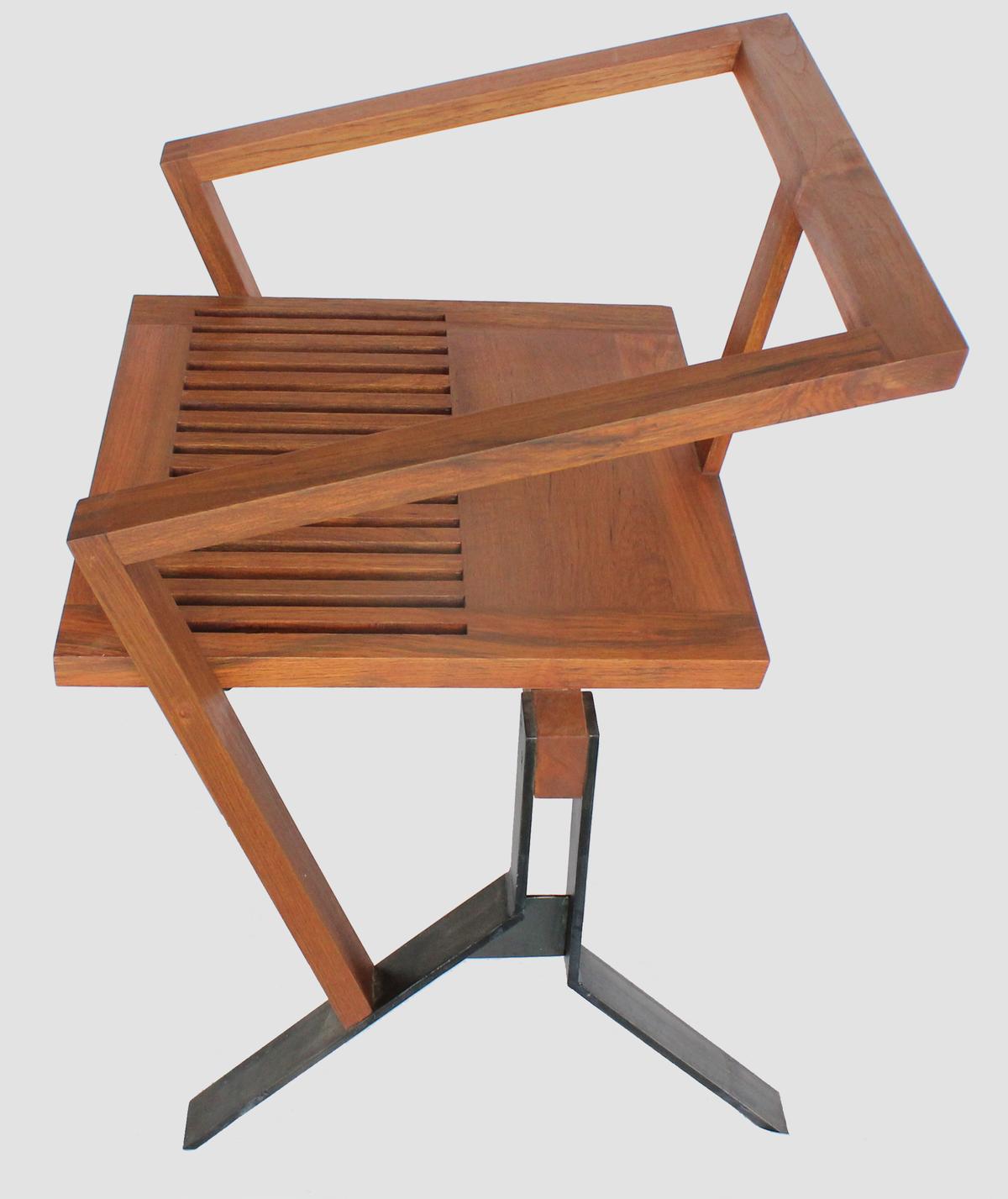
The horizontal lines on the seat, which have been treated as a series of linear perforations, help balance weight.
| Photo Credit:
Inclined Studio
‘Eunoia’ represents their love for nature and a material-driven approach. Built from a repurposed wooden log, the desk features exposed joinery and no synthetic overlays. “It is a living desk that is designed to house a bonsai plant as an intrinsic part of the piece. ‘Eunoia’ reimagines the workspace as a living ecosystem. More than a desk, it is a bridge between human creativity and the natural world. This was conceptualised not as a typical office desk, but as a piece that aligns with the energy of our studio,” quips Snehal. Both products were executed by their firm’s product design arm, Carpenters.
Tibetan table | The Concreate Story
A Tibetan chik found in a local market and antique columns from a European embassy.
| Photo Credit:
VRITIKA GERA
Adorning Nishtha Duggal’s living space is a centre table which, as she puts it, came together “rather serendipitously”. Duggal says, “I stumbled upon a beautiful Tibetan chik (a traditional woven partition or blind) at a thrift market. It immediately resonated with me, and I knew I had to give it a new lease of life. Around the same time, I had acquired four antique columns from a European embassy. We carefully cut the columns in half; two were transformed into graceful side tables, while the other two became the pedestal base for the centre table. The table itself has two overlapping planks and is crafted from a combination of solid wood (from the chik) and stone/wood detailing from the columns. Its uniqueness lies in how it merges distinct cultural narratives; with Tibetan craftsmanship meeting European architectural history and resulting in a functional yet aesthetic piece.” She adds that the table is a conversation starter and embodies the essence of storytelling through form and material.
“What excites me most is that this table is not perfect by conventional standards; instead, it carries the marks of time, the randomness of discovery, and the intentionality of design. That makes it truly one-of-a-kind,” quips Duggal.
A dog’s bed | by e & co.
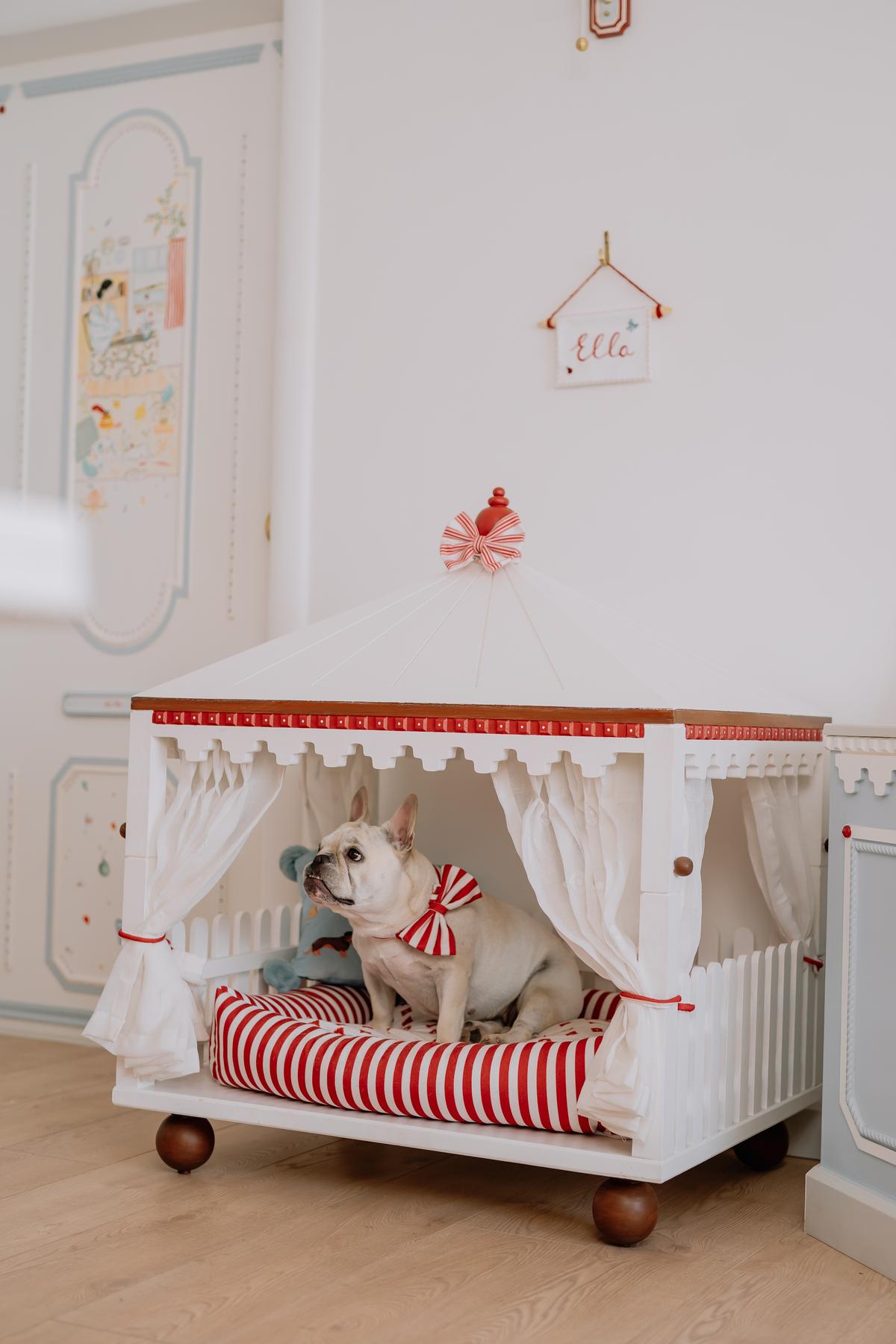
Ella’s bed.
| Photo Credit:
Tanvi Arora Seth
Eshita Marwah’s office, which has a distinct Victorian tea room vibe replete with cottage core charm, has several exclusive pieces that have been designed in-house. Two standout pieces include her pet dog Ella’s bed and the chandelier, both of which Marwah terms as deeply personal gestures. “Ella’s bed is completely handmade and hand-painted as a cosy, protective nook that blends seamlessly into the studio’s design language. The structure sits on rounded ball-like solid wood legs and is detailed with a picket-style railing, striped mattress in red and white, which goes with the rest of the space, and soft sheer curtains. The detachable pitched roof adds versatility, allowing for easy cleaning and adaptability over time. Its compact scale ensures it does not overwhelm the room while still offering Ella a space of her own. My main consideration was comfort; for Ella to feel secure and cocooned, while making the bed visually charming enough to hold its place in the office,” says Marwah. The chandelier, named ‘The Solo Waltz’, is handmade in metal and hand-painted in a cherry red tone. Its organic, leaf-like extensions spread outward in a sculptural form that feels as though it’s caught mid-motion, like in a waltz, hence the name. It not only illuminates but also forms a poetic connection to the greenery visible outside the window. “My goal was to create a functional centre piece which brought rhythm, movement, and a sense of nature indoors. Together, these pieces capture my design ethos — where utility is inseparable from emotion. They are designed not only to serve a purpose but to evoke warmth and joy every day,” adds Marwah.
Concrete dining table | Multitude of Sins
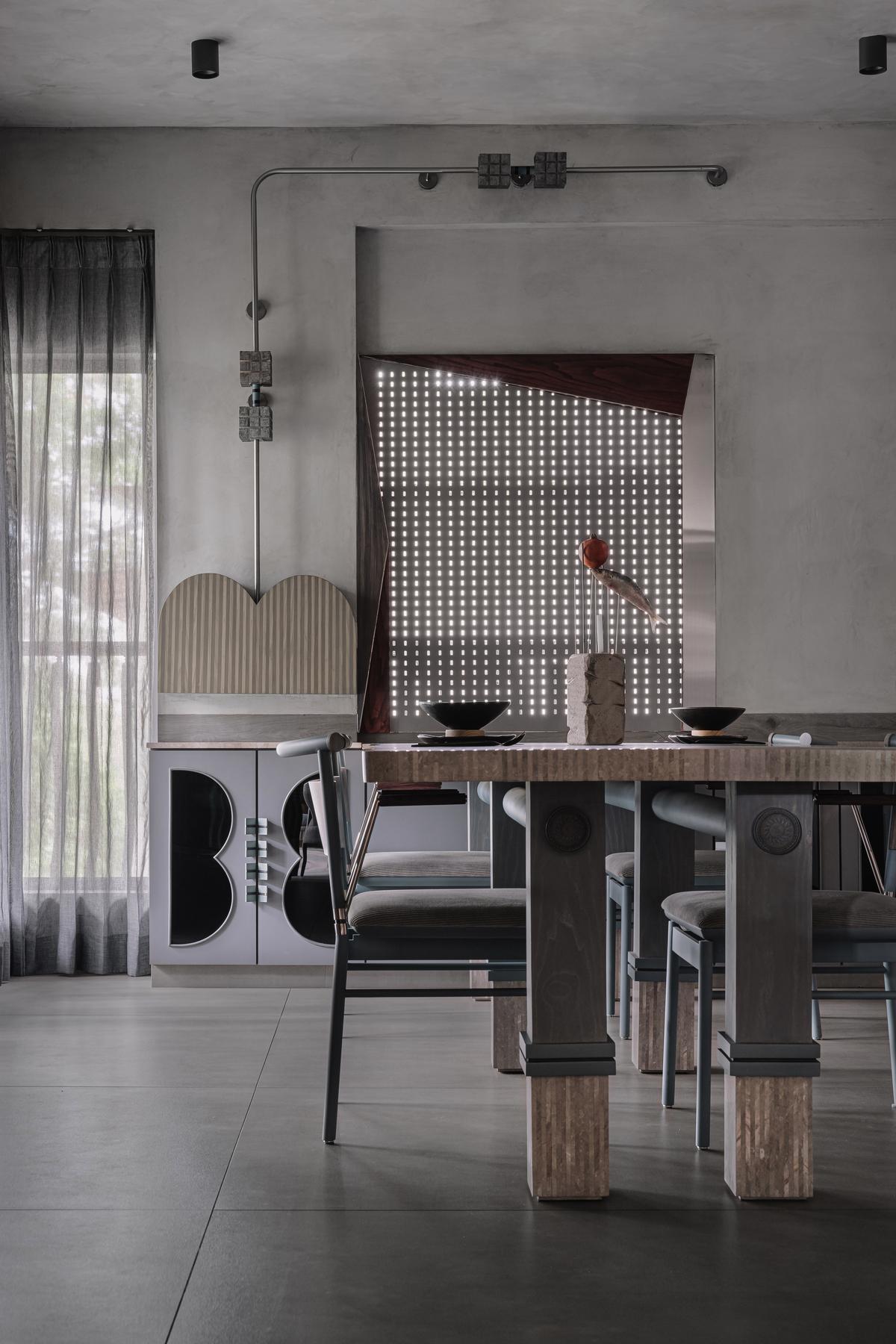
A dining table.
| Photo Credit:
ISHITA SITWALA
Inspired by her wish to enjoy a carefree dining experience, Smita Thomas decided to create a unique dining table using large concrete finish tiles. “It is a generous 10-ft.-long table that comfortably accommodates eight to nine guests. While stone, marble or wood might typically headline as tabletop material, I chose large concrete-finish tiles, which means we can spill, splatter, and enjoy meals without worrying about the aftermath. A two-shade marble inlay edges the table, curving atop the table top to frame the tiles. Between the tiles, a blue-stained wood inlay adds a touch of colour and complexity. The legs mimic tall concrete blocks in a profound stained grey, with bases featuring the same striped marble inlay as a design detail and to ward off wet mops. A cylindrical metal pipe, complete with carved wooden flowers at the ends, runs across the length of the table, connecting the legs,” says Thomas.
It is key to note that the dining table is almost an extension of the crockery unit, and the marble top of the crockery unit doubles as a buffet counter for entertaining.
Bronze-concrete balance | Studio Urban Form and Objects (UF+O)
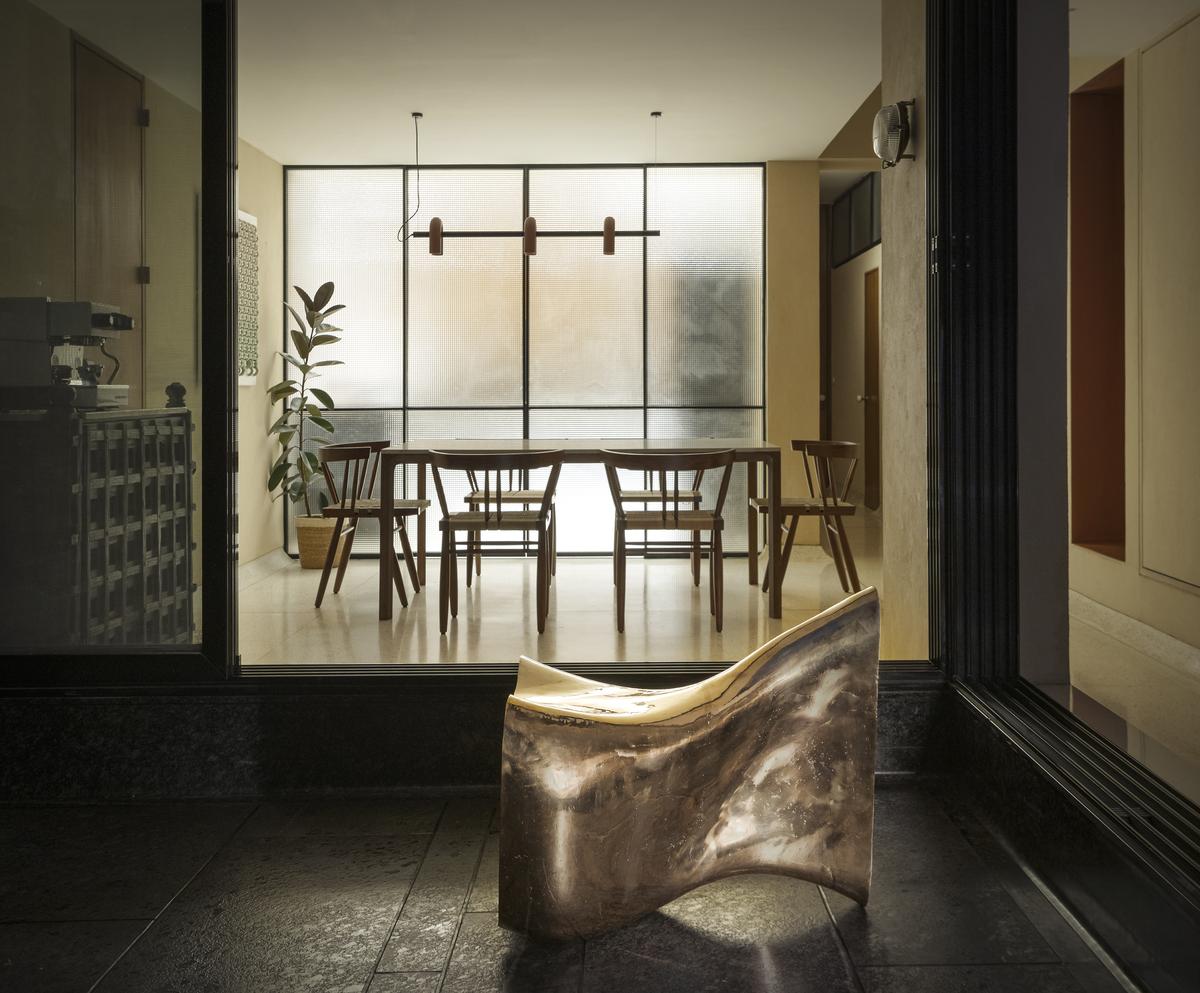
A view of the studio.
| Photo Credit:
NIVEDITAA GUPTA
Prachi Parekh Vora and Vineet Vora, co-founders of Studio UF+O, have designed an exclusive bench and lamp for their home, which they have christened ‘Inside Out’ and ‘Petal’, respectively. Both pieces push the boundaries of materiality and explore innovation in craft. Made from bronze, Inside Out is a creatively designed bench that is an interplay between material experimentation and form exploration. Bronze casting as a process was studied to attain a thin organic form with contrasting textures which offer varying tactile surfaces on the inside and outside while retaining the functionality of a seat. “Petal is a sculptural exploration, and this concrete-cast lamp rises with its fluid, petal-like form gracefully unfurling to reveal a warm, golden glow,” says Prachi. Blending minimalism with elegance, it transforms the space into a serene, ethereal ambience. “The main motivation was to explore the phase-changing properties of bronze and concrete, and we were drawn to the potential of these materials for sculpting. The experimentation was about striking a balance between controlling the material’s behaviour and embracing its inherent characteristics. We were able to play with the scale between functionality and aesthetics,” adds Vineet.
The Bengaluru-based freelance writer is passionate about all things design, travel, food, art and culture.


